Manual focus lenses.
Part III is here.
The range of dedicated prime and zoom lenses from Panasonic, Olympus, Sigma and Leica for the MFT format is now very large indeed. Over 40 lenses and counting. But that does not mean that older manual focus lenses from other makers are useless.
The Panasonic GX7 is exceptionally well attuned to the use of these older MF lenses. Mine are Nikkors but adapters are inexpensively available for just about any lens on the planet, owing to the low bayonet flange-to-sensor dimension of the slim body. That means that infinity focus will be attainable on just about every lens ever made. This means owners of old – and superb – Canon FL lenses (which, unlike the EF line which came after, have proper aperture rings), and owners of old Minolta, Leica and Leicaflex lenses can also revel in modern body technology. Don’t buy any of that ‘made for digital’ bunk used to sell modern plastic-fantastic optics. The old Canon, Nikkor, Rokkor and Leitz lenses are some of the best optics every made and most can be had for a song.
On a technical note, the distance from the optical center (nodal point) of the adapted MF FF lens to the camera’s sensor will be large, thus mitigating the incidence of light rays striking the sensor at acute angles. The MFT format cherry picks the best definition in the center of the full frame image circle of these FF optics. This helps greatly by sidestepping edge aberrations, thus requiring no lens correction profile for the lenses I highlight below.
The EVF in the Panny MFT bodies has always excelled with MF optics as it automatically adjusts to the aperture, maintaining constant brightness. So you can enjoy the strange experience of taking your f/2 MF optic, stopping it down all the way to f/22 and the only thing you will see change in the finder is the depth of field! The image maintains constant brightness as the EVF’s circuitry instantly adapts.
Secondly, the outstanding central area focus technology from the G1 and G3 continues in the GX7. Switch the rear lever to MF, double press the rear control dial, and the central part of the image is magnified up to 10x for critical central focus, the magnification adjusted with the rear control wheel.
Third, used in Aperture Preferred exposure automation mode, exposure is automatic – and correct.
But the GX7 adds two new technologies missing from its predecessors. First, you can turn on focus peaking which will outline in-focus areas in green, yellow or blue – your choice. Sometimes this really helps, especially in poor light. At worst it does no harm.
Much more importantly, the GX7, for the first time in any Panny body, adds an in-body anti-shake stabilizer (IBIS) and Panny does not stop there. The body permits you to set the stabilizer to the focal length in use and three settings can be re-programmed and saved. You can also elect two axis or single axis stabilization, the latter for tripod use.
To simplify access to this stabilizer menu, I recommend programming one of the function buttons to ‘Stabilizer’. I assigned it to the LVF (Fn4) button which is poorly placed by the eyepiece for its default purpose of switching between EVF and LCD. I then assigned the EVF/LCD function to the QMenu (Fn1) button which I would never otherwise use. Thus the Stabilizer menu can be called up with one button push, rather than having to page through many menus. The extended operating manual explains how to pre-program focal lengths of choice into the stabilizer menu. Thereafter, a simple touch on your lens of choice on the LCD display, then a touch on ‘Set’, and you are off.
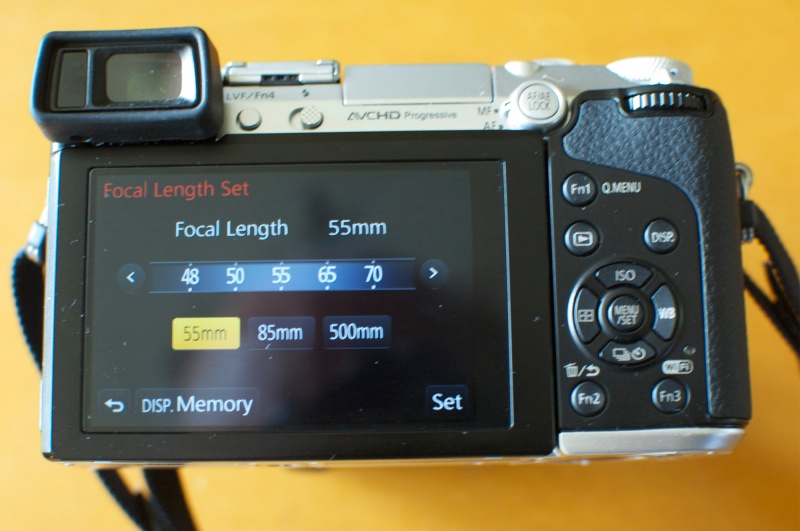
Three favorite MF Nikkors programmed into the in-body stabilizer.
Adapter: I use this $14 adapter for my Nikkors. It measures to better than 1/10,000th inch parallelism between the front and rear flanges, at which point my micrometer gives out, so it will be good enough for the most fastidious. There is absolutely no play on the GX7 on either the body or lens flange. Recommended. The adapter comes in a host of lens mount fittings. At the price asked, you can spring for one for each of your favorite MF lenses.
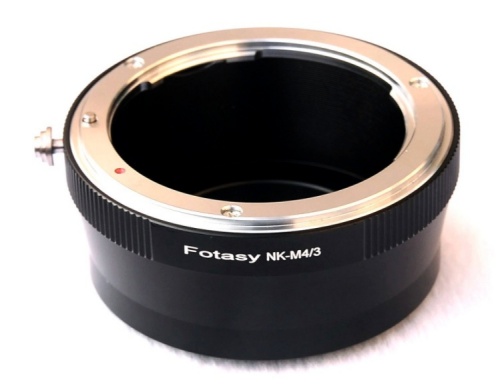
Nikkor to MFT adapter.
As I explained in my G3 review, few MF lenses actually make sense on the MFT body. You lose the automation and small size of MFT optics and have to add manual steps to make things work. But four of my Nikkors make eminent sense for use on the GX7:
55mm f/3.5 Micro Nikkor:
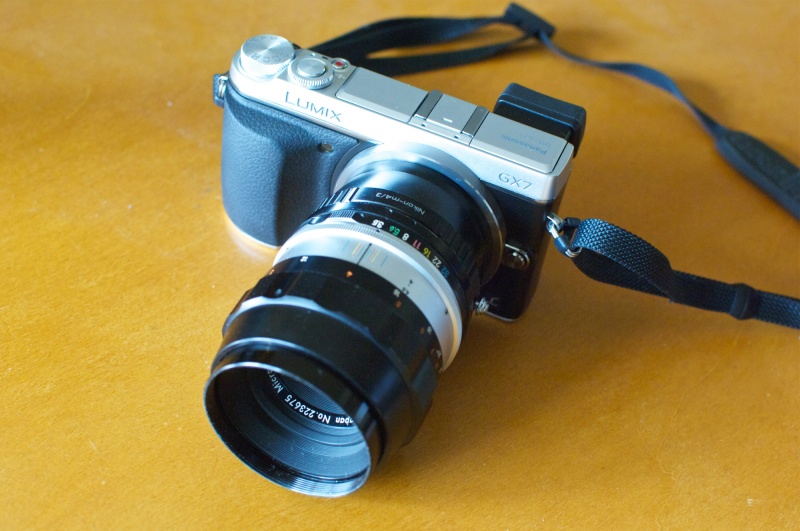
This outstanding (and very inexpensive) macro lens goes to half life-size on an FF body. It can be easily found for well under $100. On an MFT body it becomes an effective 100mm, doubling your subject distance for easier lighting, and now going down to life-life size without the need for any further adapters. MF is fine for contemplative macro use, making this a perfect companion to the GX7 body. Used on a tripod, the swiveling eyepiece and the LCD display make for ease of focus and composition. A perfect macro rig.
Here is the Micro Nikkor at closest focus – this is my D2x – at full aperture:
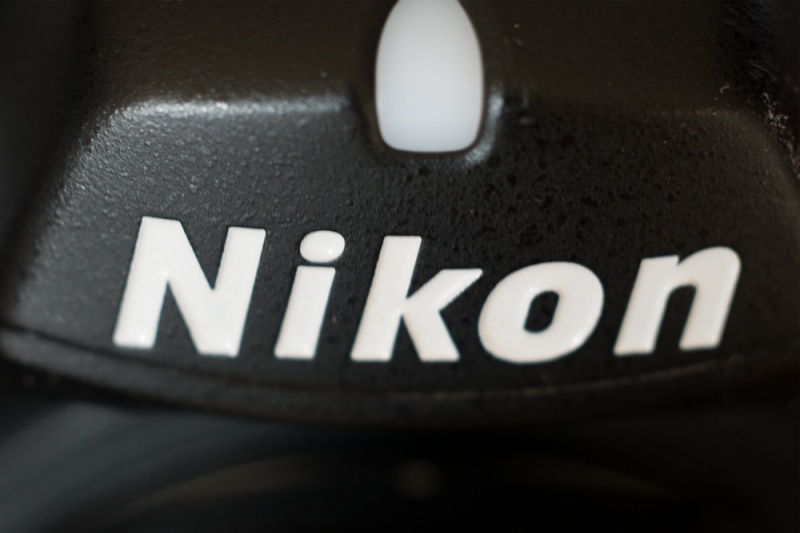
85mm f/1.8 Nikkor:
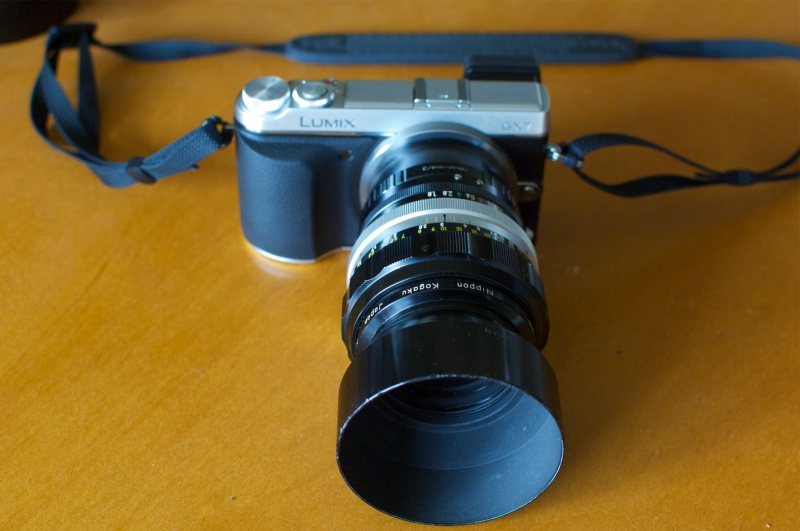
Same DOF as a 170mm lens at f/6.3.
This one needs little explanation. Imagine using a 170mm f/1.8 at full aperture with the bulk of an 85mm lens ….

With the 85mm Nikkor at f/1.8.
180mm f/2.8 ED IF AF D Nikkor:
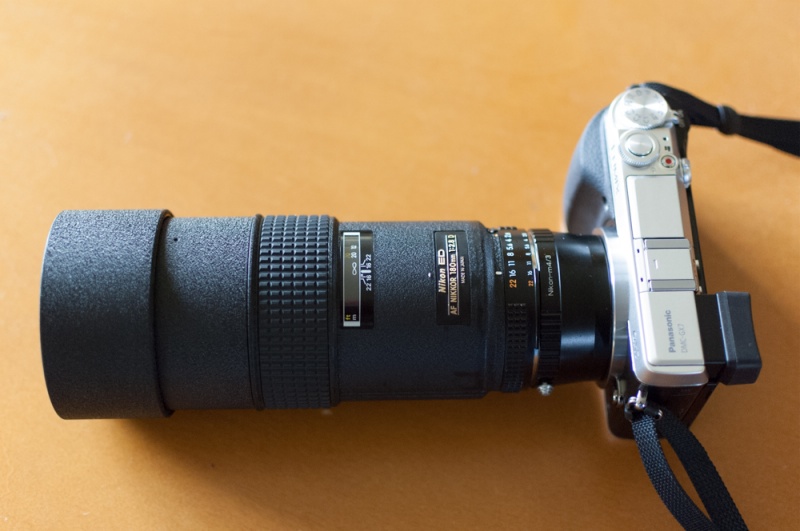
This is actually an AF D autofocus Nikkor which is easily switched to MF. D lenses have aperture rings, discontinued in the later, and current, G range. There’s one reason to use this optic and that’s to enjoy f/2.8 at an effective focal length of 360mm, where it is simply stellar. With the current 400mm AF f/2.8 Nikkor retailing at $9,000, you can do the math. The IF focus is light and precise and focus peaking really works well with this lens, for some reason. Other than that the 45-200mm MFT Panasonic zoom, which is f/5.6 at the long end, is easier to use.

Hand held at f/2.8.
500mm f/8 Mirror Reflex Nikkor:
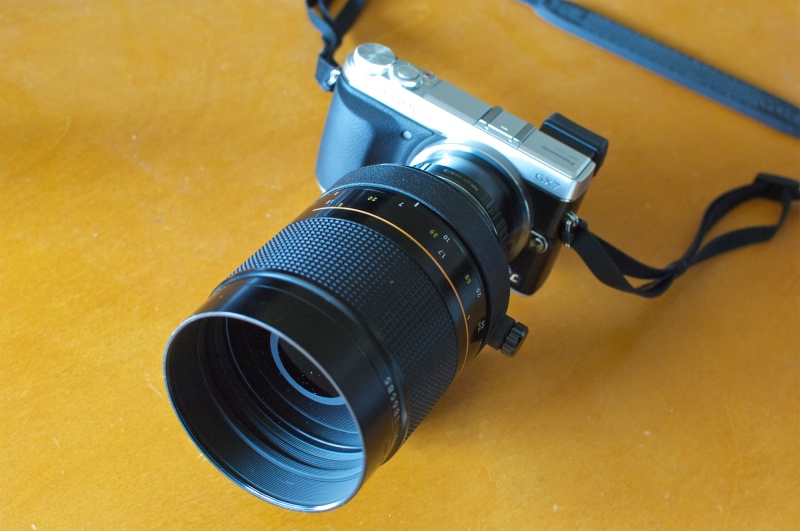
This lens is a natural for the GX7. The finder is bright, despite the slow, fixed f/8 aperture and IBIS adds what the G1/G3 sorely lacked. The outfit is very compact but you should seek out a support at all times, where possible. While there is no slapping nirror to hurt definition, the effective focal length is 1,000mm which is non-trivial to hand hold steadily, with depth of field being paper-thin. This dictates the use of the magnified central focus aid in the GX7 whenever possible. The exceptionally smooth operation of the focus collar in the Mirror Nikkor simplifies things considerably. The 1,000mm (effective) focal length is a nice step up from the 400mm (effective) limit on the Panny 45-200mm MFT optic.

This 3″ lemon was 10 feet from the camera.
500mm Reflex Nikkor. 1/100th second, ISO 400, tripod, electronic shutter with IBIS.
Effectiveness of the in-body stabilizer:
Testing with and without the stabilizer switched on I estimate that the in-body stabilizer in the GX7 is worth 2-3 shutter speeds’ improvement over a non-stabilized lens. It works as well with AF MFT lenses from Olympus (which have no in lens stabilization – I own the 9-18mm Oly) as it does with MF Nikkors.
Conclusion:
Manual focus lens use on the GX7 will never be as easy as with an Olympus or Panasonic dedicated autofocus MFT lens, but it makes sense for a few select optics. The required adapters for old Manual Focus lenses are very inexpensive and of excellent quality.
In Part V I’ll take a look at a new technology in the GX7, absent from the G1/G3 – Wifi.